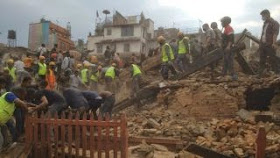Over 4500 people have been confirmed dead after an Earthquake measured as a Magnitude 7.8 event at a depth of 15 km by the United States Geological Survey struck the Lamjung District of Nepal slightly before midday local time (slightly after 6.10 am GMT) on Saturday 25 April 2015. The initial event has been followed by a number of severe aftershocks, including a Magnitude 6.6 quake that arrived about 35 minutes after the initial event.
Collapsed buildings in Kathmandu on Monday 27 April 2015. Danish Siddiqui/Reuters.
The quake is reported to have caused severe damage in eleven of of the 75 districts of Nepal, an area home to about two million people, with another 28 districts, with a population of about six million people, also affected. In addition to the known dead over 8000 people have been reported to be injured, however aid agencies working in the country fear that disruption to infrastructure may be the main danger from the event, with many people sleeping in the open due to collapsed or unsafe buildings, and severe disruption to power and water supplies as well as communication networks. Agencies are already reporting cases of diarrhea, which can spread rapidly in the absence of proper sanitation and is often the major killer in the aftermath of natural disasters.
Rescue workers looking for survivors in Khathmandu. Niranjan Shrestha/AP.
Outside Nepal the event was felt across much of the Himalayan region, and fatalities have been reported in India, China and Bangladesh. A number of foreign nationals are known to be among the dead in Nepal, with many countries reporting citizens still missing in the country. Eighteen people, including local guides and foreign tourists were killed by an avalanche that struck Everest Base Camp, and many people were trapped on the mountain itself for several days as rescue helicopters were diverted to deal with higher priority problems, though evacuations of trapped climbers have now reportedly begun.
Rescue workers treating an injured Sherpa at Everest Base Camp following the 25 April Avalanche. AFP.
Nepal is located entirely within the Himalayas, a range of mountains formed by uplift associated with the collision between the Indian and Eurasian tectonic plates. The Indian Plate is moving northwards at a rate of 5 cm per year, causing it to impact into Eurasia, which is also moving northward, but only at a rate of 2 cm per year. When two tectonic plates collide in this way and one or both are oceanic then one will be subducted beneath the other (if one of the plates is continental then the other will be subducted), but if both plates are continental then subduction will not fully occur, but instead the plates will crumple, leading to folding and uplift (and quite a lot of Earthquakes). The collision of the Indian and Eurasian plates has lead to the formation of the Himalayan Mountains, the Tibetan Plateau, and the mountains of southwest China, Central Asia and the Hindu Kush.
Animation showing how the collision of the Indian and Eurasian Plates has lead to uplift in the Himalayas. Tectonics Observatory.
See also...
 Fifteen people injured following Magnitude 5.4 Earthquake in Khyber Pakhtunkhwa Province, Pakistan.
Fifteen people injured following Magnitude 5.4 Earthquake in Khyber Pakhtunkhwa Province, Pakistan.
 Fifteen people injured following Magnitude 5.4 Earthquake in Khyber Pakhtunkhwa Province, Pakistan.
Fifteen people injured following Magnitude 5.4 Earthquake in Khyber Pakhtunkhwa Province, Pakistan.The United States Geological Survey recorded...
Eight people are known to have died and at least three more are missing after two landslides in Nepal on Monday 25 August 2014. The first incident happened at Baramchi in Sindhupalchowk District, where...
Eight people are known to have died and many more are missing following a massive landslide near Jure in the Sindhupalchowk District of Nepal on Saturday 2 August 2014. At least forty people...
Follow Sciency Thoughts on Facebook.





